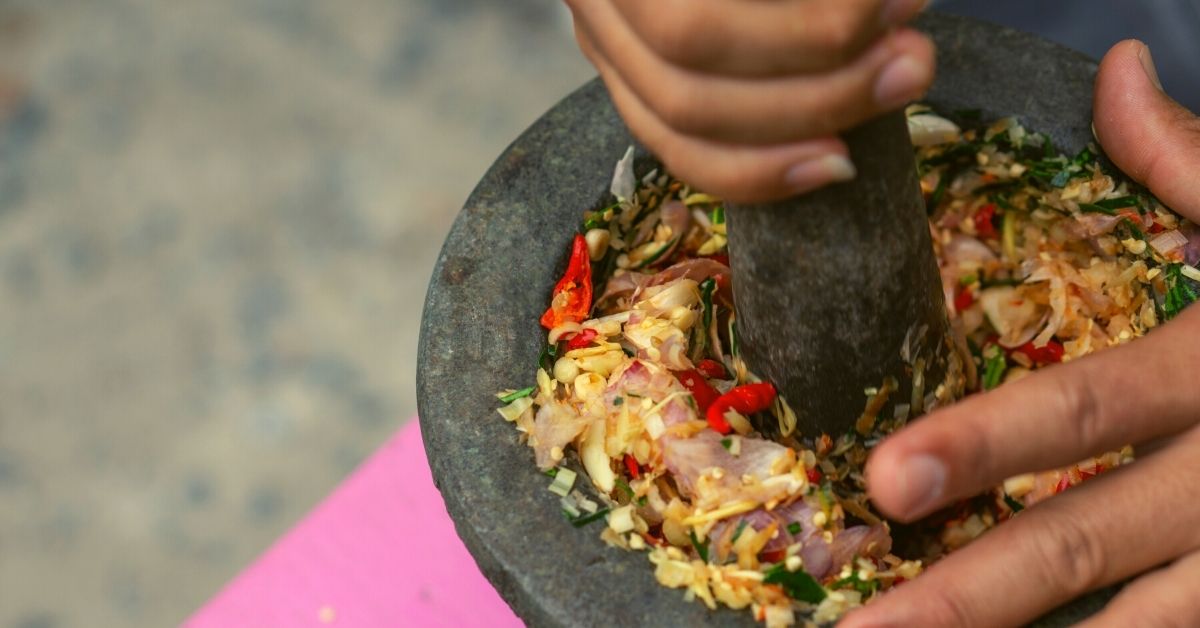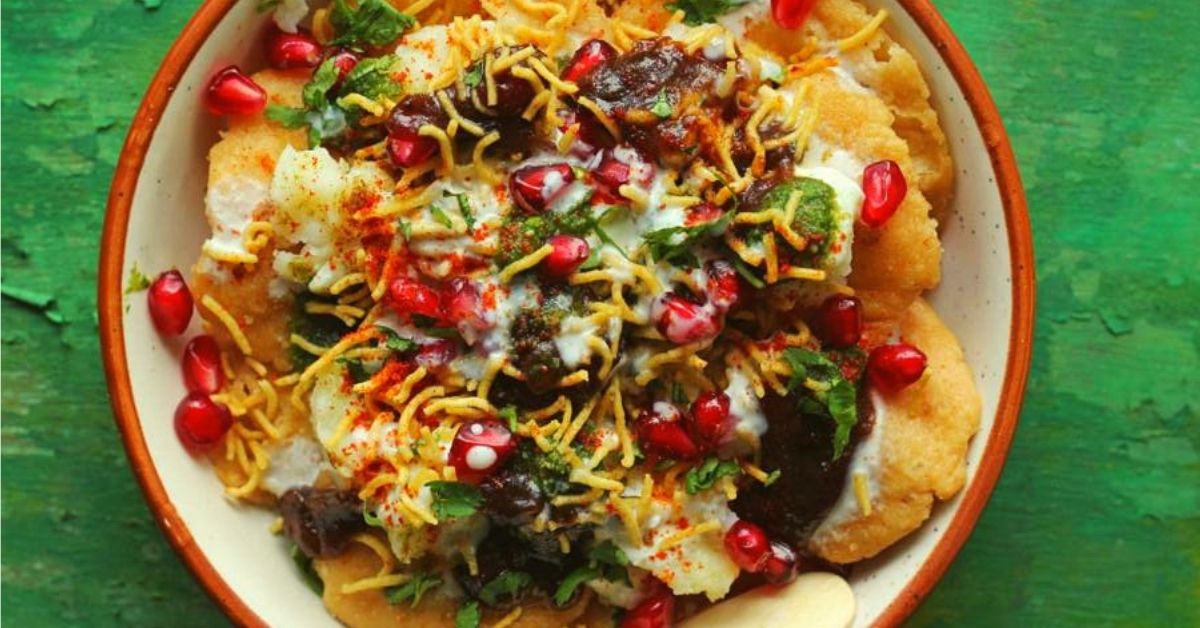How Did India Get Its Yummy Chutneys? Here’s The Story & a Map That’ll Leave You Hungry
Can you imagine the horror of eating samosas or dosas without a chutney? That's how important chutneys are in India. #FoodSecrets

Eating at a traditional Bengali ceremony, be it a wedding, birthday or religious occasion, is a lot like watching a live orchestra.
After waiting in a long serpentine queue, you finally manage to get a seat at the table and moments later, with lightning speed, an entourage of servers arrive dumping dollops of delicious food on your plate. In sync, each one of them serves the food following a special sequence — fish cutlets with kasundi come first, followed by steamed rice or basanti pulao served with dal, bhaja (fritters), torkari (vegetable side) and finally the main course of fish and meat curries. The meal then reaches a crescendo as the desserts are served.
But contrary to popular belief, desserts like payesh, sandesh, rasmalai and roshogolla are not the real saccharine stars of a grand Bengali meal. Instead, the most sought-after delicacy and a fitting epilogue to such a meal is none other than the humble chutney served with papad and fryums on the side.
Be it the spicy and tangy tomato one, the aamshotto or sticky mango one or the unusual plastic chaatni made of raw papaya, chutney is the stuff of legends in Bengal and beyond.
A delicacy bursting with flavours that is often underestimated as a condiment languishing at the margins of a plate, in Indian cuisine, chutney holds the power to make or break a meal. Although there exist several stories claiming its origin, either as an accompaniment to rice and idli, a topping for chaat, or a sweet concluding dessert, the simplistic complexity of chutney suggests it to be potentially one of the oldest foods consumed by humans.
What came first? Chutney or the Chaat?

Said to have originated from the Sanskrit word, ‘chaatni’ meaning ‘to lick’, this flavour bomb found in various forms is an integral part of India’s culinary treasure.
One of the popular stories of its origin dates back to the 17th century when Mughal emperor Shah Jahan fell ill. Legend has it that as part of the treatment, the emperor’s hakims had advised him to eat something spicy and full of flavour, yet very easy to digest. This led to the invention of chaat made of healthy ingredients like pulses and lentils, which was made interesting with a drizzle of spicy coriander and mint chutney and sweet and tangy tamarind chutney.
Made fresh, often with raw ingredients like mint, cumin, coriander, flax seeds, garlic, dry ginger, etc, chutney although served in small quantities are packed with micronutrients, that are believed to aid in digestion, as advised by Shah Jahan’s hakims.
However, despite the suggestion in this story, one cannot say that chaat led to the invention of chutney. According to food historian Pushpesh Pant, chutney in its simplest form, which is a coarse paste made by grinding an array of ingredients, could potentially be the oldest form of food prepared by homo sapiens.
“It is reasonable to suggest that the chutney is older than any other recipe known by homo sapiens. It was most likely ‘invented’ by our hunting-gathering ancestors by accident, maybe even before cooking transformed our eating habits. Crushed berries, fruit and leaves, seeds and nuts render whatever we put in our mouth tastier and slowly become a habit or preference,” he said to The Indian Express.
A culinary element that adds rasa to a meal, much like pickle, the humble chutney over the years has taken diverse forms, evolving into umami bombs exploding flavours in every corner of the world.
The exponential rise in COVID-19 infections in 2021 has been far more devastating for children than the first wave, particularly for those from underprivileged communities. To address this urgent crisis, The Better India has launched ‘To India’s Children’ — a campaign as part of which we are working with various NGOs across India to help children fight the impact of COVID-19.
Unable to view the above button? Click here
Poverty and Patriarchy
According to food historians, India’s colonial past also lends influence to the modern chutneys we know today. One of those is the popular sweet and tangy tomato chutney in Bengal. A migration from the traditional spicy baata (paste) concept, the sweet chutneys of Bengal were probably inspired by British jams and marmalades. At the time, these luscious chutneys adorned with expensive dry fruits grew to be a gastronomic symbol of status and affluence.
But the migration from traditional ingredients like kochu (colocasia), raw banana, thankuni pata (Indian pennywort), etc. was more of a socio-economic commentary than a culinary exploration.
This is because chutney in its original form is believed to be an integral part of subaltern cuisine in India. In regions with limited access to resources like fertile land and water, chutneys were made using indigenous flora and fauna. Not just a condiment to compliment the meal, chutneys were treated as a primary source of carbohydrate and protein, just like in the case of onion and garlic chutney in Maharashtra, and the fiery Chapda (red ant chutney) eaten in Chhattisgarh, Odisha and Jharkhand.
On the other hand, chutney also echoes the deep-rooted misogyny in Indian society. While several films like Chutney (2016) and The Great Indian Kitchen (2021) expose it by stressing the idea that hand-ground fine chutney is a marker of a housewife’s worth, there is a deeper connection between chutney and patriarchy.
Traditionally in India, women eat after the entire family is fed. This means, by the time the women sit to eat there’s hardly any food left for them to consume — a common phenomenon responsible for a high rate of malnutrition among women. As a solution to this, many women turn to making chutneys with easily available ingredients as a quick side dish consumed with staples like rice or roti.
Now a family favourite at home, my mother’s thankuni pata baata and spicy lyachcho chutney made with leftover shredded fish, seemingly originated as a sustainable solution practised by generations of women. A product of my great grandmother’s ingenuity, it came into being when all the women in the family had to share a single leftover piece of fish after the elders and men would finish their meal.
From being a flavour enhancer, a sweet decadence or a source of sustenance, chutney despite its diversity, for centuries, has continued to unanimously fill our bellies with a sense of satisfaction like no other. No matter how rich and elaborate the main course dishes are, chutney is and will continue to be the real star of an Indian platter.
Presenting the Chutney Map of India!
In most Indian meals, the chutney is on the margins of the plate as an accompaniment. But Indians' love for it remains a palate-pleasing thread that binds the country's multicultural eating practices together. (1/2) pic.twitter.com/uifoF4ixHd
— The Better India (@thebetterindia) June 10, 2021
Doon Chetin
Ingredients:
125 gm Kashmiri walnuts — soaked in hot water
Salt to taste
2-4 green chillies
1/2 tsp Kashmiri red chilli powder
2 tbsps fresh mint leaves
1 Onion- roughly chopped
1/4 tsp shahi jeera (black cumin)
3/4 cup fresh hung curd
¼ tsp Dried mint leaves, crushed
Salt to taste
Method:
Blend all the ingredients to make a fine paste. Taste and add the seasonings as per preference. Garnish with dry mint and serve with fried snacks, tandoori or rice dishes.
Courtesy: Chef Reetu Uday Kugaji
Thankuni Pata chutney
Ingredients:
100 g of thankuni pata or Indian pennywort leaves
4-6 Green chillies
½ Onion- chopped
10-15 cloves of Garlic
½ tbsp Black cumin seeds
1 tbsp Mustard oil
Salt to taste
Sugar to taste (optional)
Method:
Blend the leaves, green chillies, onion, garlic and black cumin seeds into a fine paste. Fry the paste in mustard oil for a few minutes until all the water from the leaves evaporates, leaving a semi-dry texture. Add salt and sugar to taste
Courtesy: Indrani Barua
Fish chutney or Lyachcho
Ingredients:
1 to 2 pieces of leftover fish- fried and shredded
1 Onion- finely chopped
4-6 Green chillies- finely chopped
4 tbsp Turmeric leaves- finely chopped
2 tbsp Coriander leaves- finely chopped
½ cup red-coloured young Mango leaves- finely chopped
1 ½ tbsp wild tulsi leaves- finely chopped (optional)
2 tbsp Mustard oil
Salt to taste
Method:
De-bone the fried piece(s) of fish and mince it with onion and green chillies. Green chillies can be either fried or raw. Incorporate 1 tbsp of mustard oil with all the ingredients in a mortar and pestle to make a coarse paste. Make small balls of the semi-dry chutney and top it up with another tbsp of oil.
Courtesy: Indrani Barua
Gongura Pachandi
Ingredients:
2 bunches of Gongura leaves
1 cup Water
4 tbsp oil
2 Onion- finely chopped
3 Garlic cloves- crushed
2 Tomato-finely chopped
5-6 Green chilli- slit in middle
1 tsp Turmeric powder
Salt to taste
For Tadka-
1 tbsp oil
1 tsp Mustard seeds
2 Garlic cloves- finely chopped
2 Red chilli whole
a sprig of Curry leaf
Method:
Heat the oil and fry the onion. Once translucent, add garlic, green chillies and continue to fry. Then add turmeric powder, tomato and cook. Once the tomato is tender, add the gongura leaves and a cup of water. Cook till the gongura leaves are tender and change the colour. Add seasoning and blend it into a coarse paste.
Courtesy: Fast Kitchen
Edited By Yoshita Rao
If you found our stories insightful, informative, or even just enjoyable, we invite you to consider making a voluntary payment to support the work we do at The Better India. Your contribution helps us continue producing quality content that educates, inspires, and drives positive change.
Choose one of the payment options below for your contribution-
By paying for the stories you value, you directly contribute to sustaining our efforts focused on making a difference in the world. Together, let’s ensure that impactful stories continue to be told and shared, enriching lives and communities alike.
Thank you for your support. Here are some frequently asked questions you might find helpful to know why you are contributing?


This story made me
-
97
-
121
-
89
-
167











